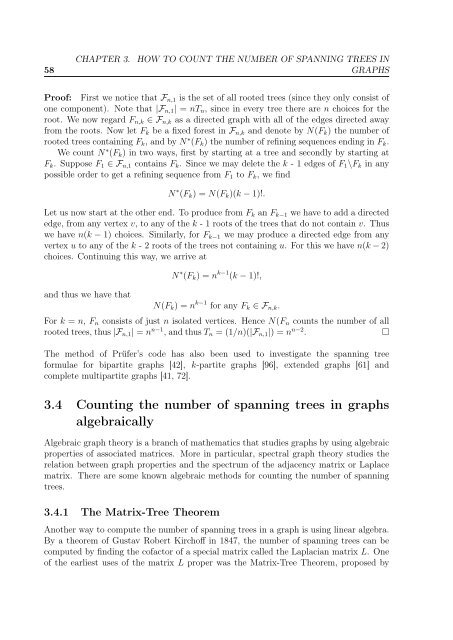enumeration of the number of spanning trees in some ... - Toubkal
enumeration of the number of spanning trees in some ... - Toubkal
enumeration of the number of spanning trees in some ... - Toubkal
Create successful ePaper yourself
Turn your PDF publications into a flip-book with our unique Google optimized e-Paper software.
58CHAPTER 3.HOW TO COUNT THE NUMBER OF SPANNING TREES INGRAPHSPro<strong>of</strong>: First we notice that F n,1 is <strong>the</strong> set <strong>of</strong> all rooted <strong>trees</strong> (s<strong>in</strong>ce <strong>the</strong>y only consist <strong>of</strong>one component). Note that |F n,1 | = nT n , s<strong>in</strong>ce <strong>in</strong> every tree <strong>the</strong>re are n choices for <strong>the</strong>root. We now regard F n,k ∈ F n,k as a directed graph with all <strong>of</strong> <strong>the</strong> edges directed awayfrom <strong>the</strong> roots. Now let F k be a fixed forest <strong>in</strong> F n,k and denote by N(F k ) <strong>the</strong> <strong>number</strong> <strong>of</strong>rooted <strong>trees</strong> conta<strong>in</strong><strong>in</strong>g F k , and by N ∗ (F k ) <strong>the</strong> <strong>number</strong> <strong>of</strong> ref<strong>in</strong><strong>in</strong>g sequences end<strong>in</strong>g <strong>in</strong> F k .We count N ∗ (F k ) <strong>in</strong> two ways, first by start<strong>in</strong>g at a tree and secondly by start<strong>in</strong>g atF k . Suppose F 1 ∈ F n,1 conta<strong>in</strong>s F k . S<strong>in</strong>ce we may delete <strong>the</strong> k - 1 edges <strong>of</strong> F 1 \F k <strong>in</strong> anypossible order to get a ref<strong>in</strong><strong>in</strong>g sequence from F 1 to F k , we f<strong>in</strong>dN ∗ (F k ) = N(F k )(k − 1)!.Let us now start at <strong>the</strong> o<strong>the</strong>r end. To produce from F k an F k−1 we have to add a directededge, from any vertex v, to any <strong>of</strong> <strong>the</strong> k - 1 roots <strong>of</strong> <strong>the</strong> <strong>trees</strong> that do not conta<strong>in</strong> v. Thuswe have n(k − 1) choices. Similarly, for F k−1 we may produce a directed edge from anyvertex u to any <strong>of</strong> <strong>the</strong> k - 2 roots <strong>of</strong> <strong>the</strong> <strong>trees</strong> not conta<strong>in</strong><strong>in</strong>g u. For this we have n(k − 2)choices. Cont<strong>in</strong>u<strong>in</strong>g this way, we arrive atand thus we have thatN ∗ (F k ) = n k−1 (k − 1)!,N(F k ) = n k−1 for any F k ∈ F n,k .For k = n, F n consists <strong>of</strong> just n isolated vertices. Hence N(F n counts <strong>the</strong> <strong>number</strong> <strong>of</strong> allrooted <strong>trees</strong>, thus |F n,1 | = n n−1 , and thus T n = (1/n)(|F n,1 |) = n n−2 .□The method <strong>of</strong> Prüfer’s code has also been used to <strong>in</strong>vestigate <strong>the</strong> <strong>spann<strong>in</strong>g</strong> treeformulae for bipartite graphs [42], k-partite graphs [96], extended graphs [61] andcomplete multipartite graphs [41, 72].3.4 Count<strong>in</strong>g <strong>the</strong> <strong>number</strong> <strong>of</strong> <strong>spann<strong>in</strong>g</strong> <strong>trees</strong> <strong>in</strong> graphsalgebraicallyAlgebraic graph <strong>the</strong>ory is a branch <strong>of</strong> ma<strong>the</strong>matics that studies graphs by us<strong>in</strong>g algebraicproperties <strong>of</strong> associated matrices. More <strong>in</strong> particular, spectral graph <strong>the</strong>ory studies <strong>the</strong>relation between graph properties and <strong>the</strong> spectrum <strong>of</strong> <strong>the</strong> adjacency matrix or Laplacematrix. There are <strong>some</strong> known algebraic methods for count<strong>in</strong>g <strong>the</strong> <strong>number</strong> <strong>of</strong> <strong>spann<strong>in</strong>g</strong><strong>trees</strong>.3.4.1 The Matrix-Tree TheoremAno<strong>the</strong>r way to compute <strong>the</strong> <strong>number</strong> <strong>of</strong> <strong>spann<strong>in</strong>g</strong> <strong>trees</strong> <strong>in</strong> a graph is us<strong>in</strong>g l<strong>in</strong>ear algebra.By a <strong>the</strong>orem <strong>of</strong> Gustav Robert Kirch<strong>of</strong>f <strong>in</strong> 1847, <strong>the</strong> <strong>number</strong> <strong>of</strong> <strong>spann<strong>in</strong>g</strong> <strong>trees</strong> can becomputed by f<strong>in</strong>d<strong>in</strong>g <strong>the</strong> c<strong>of</strong>actor <strong>of</strong> a special matrix called <strong>the</strong> Laplacian matrix L. One<strong>of</strong> <strong>the</strong> earliest uses <strong>of</strong> <strong>the</strong> matrix L proper was <strong>the</strong> Matrix-Tree Theorem, proposed by

















